Professors talk tourism on inaugural Idita-trip
by joey |
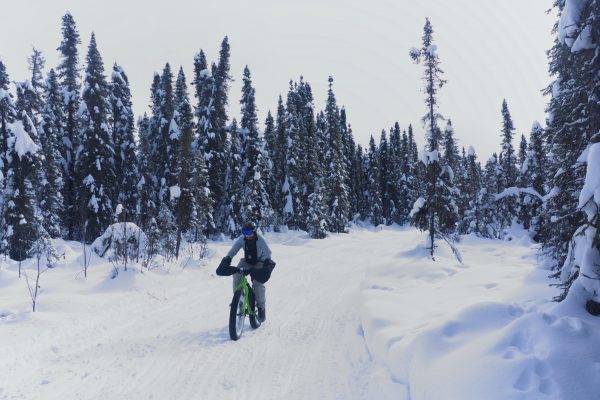
Professor T.J. Miller biking in Nancy Lakes State Recreation Area. He is one of three professors who rented a public use cabin to run a trial trip focused on sustainable tourism at UAA. (Photo by J. Besl / University of Alaska Anchorage)
Tourism is a pillar of Alaska's economy, alongside oil and fishing. But while the University of Alaska provides significant research and even doctoral degrees in those other arenas, there's a far dimmer spotlight on tourism.
Tourism, though, brings in 2 million visitors and nearly $2 billion annually. It's the second largest private sector employer, with an economic impact of $4.17 billion. So why aren't we emphasizing it?
UAA professors Herminia Din, Audrey Taylor and T.J. Miller are hoping to start that conversation. How can the university use tourism as a platform to increase awareness and engagement in a changing Arctic?
"There's a lot of evidence that places that don't have a tourism research sector and management strategy get pretty quickly overwhelmed," said Taylor, a professor of geography and environmental studies, citing Iceland as an example.
Iceland has seen its tourist numbers quadruple since 2010, and visitors now outnumber citizens seven-to-one. That massive influx strains the settings that draw people in the first place; the government is now considering a "nature tax" to preserve its environment amid the rising tide of tourism.
Alaska's industry is still economically anchored along the Southeast cruise circuit, but retreating sea ice has already opened new routes in Northern and Western Alaska. Visitors can take a cruise ship to Nome without recognizing the changing conditions that allowed them to get there in the first place.
"[Tourists] can come and go, but they never have a chance to the see the state's issues and environment by participating," noted Din, a UAA art professor.
Din attended last year's Relate North conference, hosted by the Arctic Sustainable Arts and Design network, and returned to Anchorage eager to talk about sustainable tourism development. And where better to discuss Arctic awareness than in a remote island cabin on an ice-locked lake?
"I emailed T.J. and said 'Hey, I have another crazy idea," Din said with a laugh (Miller, a professor of physical education, previously had students build an icy obstacle course for Din's Winter Design Project).
The trio convened through the fall and, on March 4 and 5, ran a one-night "Idita-trip" in Nancy Lake State Recreation Area.
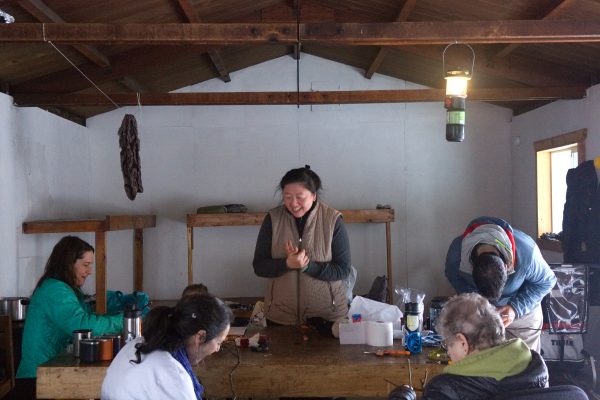
Guests and professors work on a morning art project at the public use cabin used for the "Idita-trip" earlier this month. (Photo by J. Besl / University of Alaska Anchorage)
An interdisciplinary itinerary
The interdisciplinary itinerary drew on the three professors' focus areas - Din's place-based art installations, Taylor's interest in citizen science, and Miller's expertise in outdoor recreation.
"In the university, we rarely do these beautiful things across departments," Din noted.
The trip was a test run for what they hope becomes a regular event. They handpicked a small guest list, ranging in age from toddlers to grandmothers, and brought them to the start of the Iditarod in Willow, followed by a night at a nearby public-use cabin.
Since sustainable tourism was the focus, the group kept environmental impact in mind. Most guests reached the cabin fuel-free, using dog sleds, fat bikes and cross-country skis to cover the eight-mile route. Everyone received reusable utensils, and plastic was cut to a minimum (even the trail mix was packed in paper, folded tight to avoid the need for tape).
With home-cooked dinners and chats around the woodstove, this was not a typical tourist experience. More rustic than a cruise ship yet more livable than a tent, the public-use cabin catered to the middle ground between fresh-washed sheets and frostbit feet - an ideal spot to discuss the research and responsibility of life in a changing Arctic.
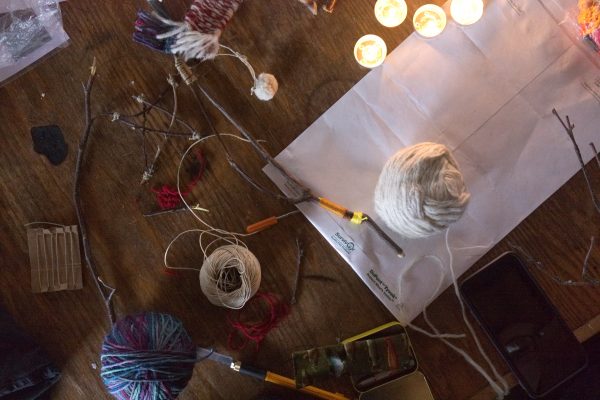
Craft supplies and tea lights scatter the table during the inaugural "Idita-trip". (Photo by J. Besl / University of Alaska Anchorage)
Coffee and crafting
In the morning, as the sun slowly rose, breakfast bled into art class. Miller collected sticks that Din used to lead a weaving project. Taylor headed out to record snow depth and current temperatures, which the group later provided to IceWatch USA.
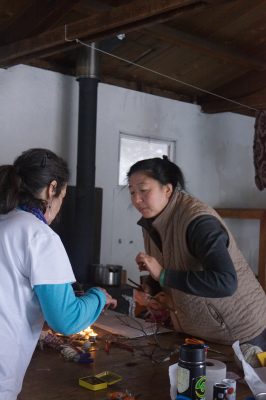
Din instructs a guest during a morning art project. (Photo by J. Besl / University of Alaska Anchorage)
During the mellow morning, conversations shifted from marine debris on Arctic islands to the shifting territory of Alaska hares. In the afternoon, two of Miller's physical education students arrived to help shuttle everyone back to the bus.
Din provided a few keepsakes for guests, like their woven art projects, satchels repurposed from flannel shirts, and beeswax-coated cloths to replace plastic wrap in the kitchen. These sustainable souvenirs also played into Miller's field of outdoor leadership.
"A big thing about experiential education and immersive education is that you have a token," he explained. These keepsakes bring the participant back to the mood and mindset of their experience. Next time they use their silverware kit, for example, a guest can recall the time they recorded ice depth for a national database, and remember to do the same on their next adventure, too.
That concept is especially important for Taylor's citizen science focus. Everyone can collect environmental data, she said, if they simply remember their role as citizen-scientists. In fact, Arctic tourists can even be a boost to the research community.
"Scientists will have to spend $100,000 to get a crew of people to some remote place in northern Canada, but a cruise ship might be going there every year," she noted.
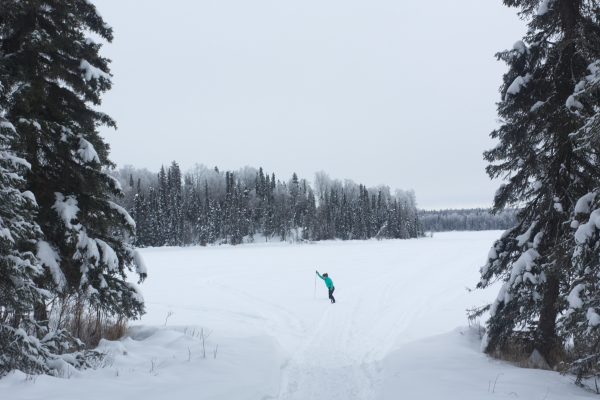
Taylor recording snow depth at Red Shirt Lake. (Photo by J. Besl / University of Alaska Anchorage)
Next steps in the North
Though the Idita-trip is over, the ideas are just beginning. The three are planning a fall trip in September, the same month they hope to present their concept at the UArctic Congress in Finland. This summer, Taylor will convene a session at the POLAR2018 conference discussing how tourists can assist in scientific data collection. They're also joining the UArctic Thematic Network on Northern Tourism, working with Professor Patrick T. Maher at Cape Breton University.
Their energy is as boundless as the opportunities ahead. They could continue to host faculty-led trips, or design a package for tour companies that invites UAA faculty to share Arctic research with guests.
But whether it becomes a start-up, a center, or a certificate program, these initiatives benefit both tourists and the university.
"This is an opportunity for students," Miller said. Physical education students could lead the trips, for example, or geology majors could answer questions on the bus to Matanuska Glacier.
"If it turns into a degree, that's great. If not and it's just a training I can provide, that's awesome.
"Ultimately, I'd love to see a sustainable tourism degree at UAA."
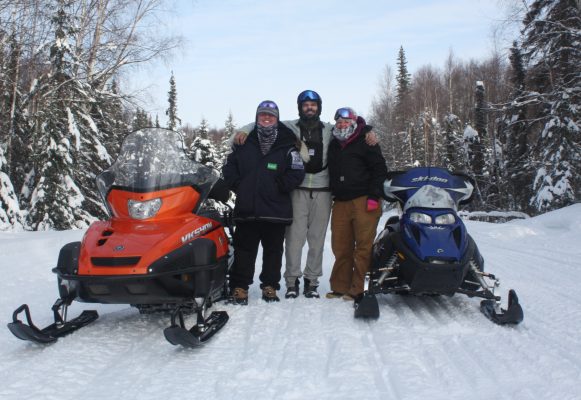
Miller with physical education seniors Robert Forto, left, and Miranda Sheely, who helped deliver guests and gear to the cabin via dog-sled and snow machine. (Photo by J. Besl / University of Alaska Anchorage)
Written by J. Besl, UAA Office of University Advancement
 "Professors talk tourism on inaugural Idita-trip" is licensed under a Creative Commons Attribution-NonCommercial 4.0 International License.
"Professors talk tourism on inaugural Idita-trip" is licensed under a Creative Commons Attribution-NonCommercial 4.0 International License.














